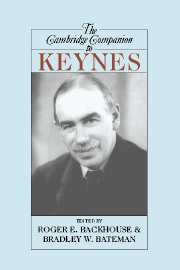Book contents
- Frontmatter
- 1 A cunning purchase: the life and work of Maynard Keynes
- 2 The Keynesian revolution
- 3 Keynes and the birth of modern macroeconomics
- 4 Keynes as a Marshallian
- 5 Doctor Keynes: economic theory in a diagnostic science
- 6 Keynes and British economic policy
- 7 Keynes and Cambridge
- 8 Keynes and his correspondence
- 9 Keynes and philosophers
- 10 Keynes’s political philosophy
- 11 Keynes and probability
- 12 The art of an ethical life: Keynes and Bloomsbury
- 13 Keynes and ethics
- 14 Keynes between modernism and post-modernism
- 15 Keynes and Keynesianism
- Bibliography
- Index
15 - Keynes and Keynesianism
Published online by Cambridge University Press: 28 November 2006
- Frontmatter
- 1 A cunning purchase: the life and work of Maynard Keynes
- 2 The Keynesian revolution
- 3 Keynes and the birth of modern macroeconomics
- 4 Keynes as a Marshallian
- 5 Doctor Keynes: economic theory in a diagnostic science
- 6 Keynes and British economic policy
- 7 Keynes and Cambridge
- 8 Keynes and his correspondence
- 9 Keynes and philosophers
- 10 Keynes’s political philosophy
- 11 Keynes and probability
- 12 The art of an ethical life: Keynes and Bloomsbury
- 13 Keynes and ethics
- 14 Keynes between modernism and post-modernism
- 15 Keynes and Keynesianism
- Bibliography
- Index
Summary
One of the most significant changes in the economic and political life of the twentieth century was the introduction of demand management in the industrialized democracies. From Japan to the United States, and from Sweden to Italy, national governments took on responsibility for a kind of economic function that had not previously been seen as a regular part of their brief: they began to use fiscal and monetary policy to try to stabilize the business cycle by stabilizing the total demand for goods and services.
Fiscal policy consists of the government's expenditures on goods and services (from pens and paper to fighter bombers), and monetary policy consists of controlling the creation of money and the level of interest rates. Both of these functions existed and were discussed in the previous two centuries, but they took on a new life in the twentieth century as a part of electoral politics and understood as a means to stabilize the swings in output that constitute the business cycle. Banking policy and government debt had been issues well before the twentieth century, but they had not been conceived of in a systematic way as the means to achieve economic stability. Inevitably, this revolution in economic management (indeed, in economic self-understanding) bears the name of John Maynard Keynes.
- Type
- Chapter
- Information
- The Cambridge Companion to Keynes , pp. 271 - 290Publisher: Cambridge University PressPrint publication year: 2006
- 18
- Cited by

